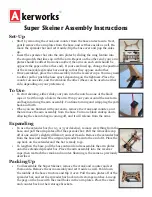
20
The presser foot pressure is pre-set for
sewing on medium weight fabric. When
sewing in different fabric weights, adjustment
might be needed. Generally, decrease the
presser foot pressure when sewing in light
weight fabric and increase it when sewing in
heavy weight fabrics. Always test sew on a
sample of your fabric before sewing on your
project. Increase or decrease the pressure in
small increments by turning the presser foot
pressure screw.
Less pressure:
Decrease the pressure
by turning the adjustment knob in counter-
clockwise direction towards the "–".
Back to standard setting:
Turn the
adjustment knob until the distance from the
front cover to the “head” of the screw is 10mm
(3/8").
More pressure:
Increase the pressure by
turning the adjustment knob in clockwise
direction towards the "+".
10mm
3/8"
Presser foot pressure adjustment
Summary of Contents for NL11C
Page 1: ...I Instruction Manual NL11C NecchiAIO...
Page 2: ......
Page 7: ...Machine Introduction...
Page 16: ...Machine Settings...
Page 30: ...Stitch Chart...
Page 36: ...Sewing Basics...
Page 43: ...Maintenance And Trouble Shooting...
Page 50: ......
Page 51: ......
















































